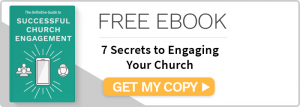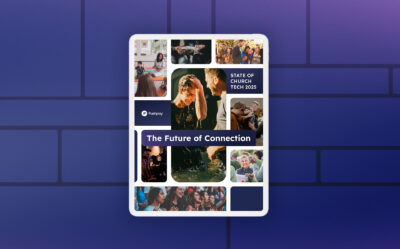
Extend the Life and Impact of Your Weekly Sermons
You put a lot of work into your sermons. Why not get the most from them? Here are ways to share and reuses your sermons to increase their impact.
Between researching, writing, creating slides, practicing, and editing, pastors pour a ton of time and energy into every sermon they preach. Some pastors plan their sermons months ahead, to ensure they have enough time to prepare.
And when they’re done preaching, they set that sermon aside and start on the next one. Maybe it gets saved on a hard drive with the intention of using it years down the road. Or maybe it never gets used again.
It’s impossible to measure the impact of a single sermon or to know how long it resonates with your congregation, but one thing is for sure: Most pastors don’t get maximum mileage out of their sermons. Just because you’re done preaching a sermon doesn’t mean that it’s no longer useful.
If you want to increase the life of your sermons and get the most value out of them, there are several things you can do to keep them on church members’ minds and expose your message to more people.
Sermon recordings
Recording your sermons is one of the easiest ways to increase their longevity and impact. If church members miss a service, sermon recordings give them a chance to catch up. This is especially valuable when you’re in a sermon series, or if small group meetings discuss your messages throughout the week. And even if members attend, recordings give them the opportunity to revisit what you said, re-experience the parts that impacted them the most, and share them with friends and family members.
Recordings are also a valuable way for people outside your church to see what your church is really like. They can experience an entire message before they ever set foot on your campus.
Your recordings should live in a prominent location on your church website and in your church app, so people have convenient access to them. Plus, adding sermons to your site is a great way to optimize it and improve its impact.
People spend five hours a day on their mobile device and most of that time is spent using a mobile app. Hosting your sermons in a custom church app is the best way to make them live on beyond your weekend service. If your church doesn’t have a custom church app, talk to a church technology expert to see how an app can best serve your church community.
Social media posts
It’s easy to think of your sermon as one cohesive piece. Every point within your message builds on the others and connects to a larger vision, so it might be hard to imagine how that could translate to social media. You can’t expect people to read a wall of text or jump into a 30-minute video on Facebook.
And that’s where sermon highlights come in.
If you record your sermons, there are probably clips that can stand on their own. Maybe there are a few brilliant lines buried in the middle, or that you saved for the end. Or perhaps a two-minute section where you tie everything together and summarize your main points. Or you give people a clear application to use throughout the week.
Even if you don’t record your sermons, you can still recycle your message into social media posts in the same ways by identifying the most compelling parts of the transcript. People share the things that inspire, encourage, or resonate with them—using social media can help your message go viral and live for a long time online.
Plus, by putting snippets of your sermon online in places where your congregation (and even people outside your church) can encounter them, you reinforce the most important parts of your message and make your content available to a wider audience.
Blog posts
When you craft your sermon, you develop a good hook that introduces your main idea, work through supporting points, and tie them together. It’s very similar to the process of writing a blog post, which is why it’s pretty easy to share your sermons on your church’s blog.
If you copy your sermon word-for-word into a document, it’d probably look like an overwhelmingly long blog post. But that’s OK. The point is to make sure your congregation has a place to revisit your message, explore it in a new way, and continue to grow from your insights. If you feel like every part of your sermon is readable, valuable, and important to your message, then who cares how long it is?
Just be sure you make it skimmable.
Every time your sermon changes topic, leads into a new point, or launches into a tangent or subpoint, give it a heading. This makes it easy for people to get a bird’s eye view of what each section will be about, so they can decide if they want to dive in or skip ahead. This makes even long blog posts a lot more readable, and it keeps your message from feeling like a wall of text.
Bullet points are especially useful. Add a few bullets to highlight critical pieces of information. Someone should be able to skim your bullet points and walk away understanding the key things you want your blog to communicate.
You might also consider creating a “light” version of your sermon to live on your blog. If you’re worried about short attention spans, just focus on the key points of your sermon and save the rest for something else.
Get more from the work you already do
Running a blog, posting on social media, and maintaining a sermon archive on your church app might sound like a lot more work, but the reality is it’s not that much more work than you’re doing right now. This isn’t creating content from scratch, it’s recycling and maximizing the work you’ve already done.
In fact, this may be a weekly responsibility that you can delegate to another staff member, or possibly even a volunteer. You’ve already done the hardest part—writing and delivering the sermon. Recycling it into other content is just a matter of choosing the most shareable moments or reformatting your sermon for other platforms.
By finding more ways to use your sermons, you’ll keep your congregation engaged as they continue exploring your insights.
You put a lot of work into your sermons, and your message is timeless—don’t limit it to 35 minutes during a weekend service. Extending the life of your sermons is a key way to make affordable church content.
Discover how else your church can get the most from the videos, audio content, and written content you produce to better engage your community with your church’s message. Click here to download The Definitive Guide To Successful Church Engagement today!






